汉译英第一讲(词的翻译技巧).
汉译英翻译的技巧
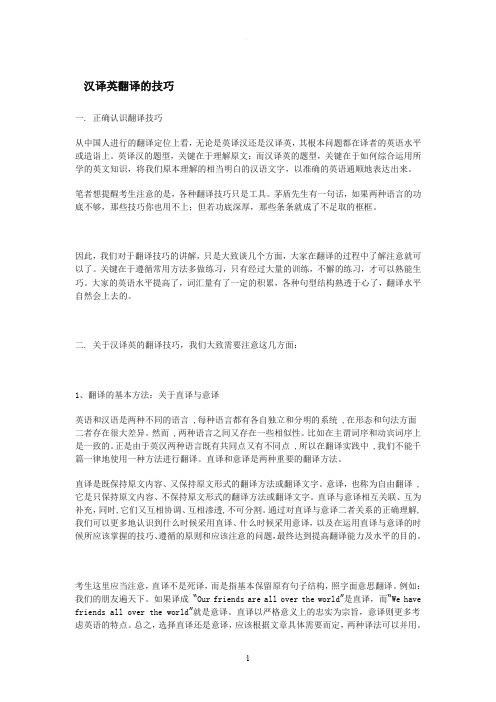
汉译英翻译的技巧一. 正确认识翻译技巧从中国人进行的翻译定位上看,无论是英译汉还是汉译英,其根本问题都在译者的英语水平或造诣上。
英译汉的题型,关键在于理解原文;而汉译英的题型,关键在于如何综合运用所学的英文知识,将我们原本理解的相当明白的汉语文字,以准确的英语通顺地表达出来。
笔者想提醒考生注意的是,各种翻译技巧只是工具。
茅盾先生有一句话,如果两种语言的功底不够,那些技巧你也用不上;但若功底深厚,那些条条就成了不足取的框框。
因此,我们对于翻译技巧的讲解,只是大致谈几个方面,大家在翻译的过程中了解注意就可以了。
关键在于遵循常用方法多做练习,只有经过大量的训练,不懈的练习,才可以熟能生巧。
大家的英语水平提高了,词汇量有了一定的积累,各种句型结构熟透于心了,翻译水平自然会上去的。
二. 关于汉译英的翻译技巧,我们大致需要注意这几方面:1、翻译的基本方法:关于直译与意译英语和汉语是两种不同的语言 ,每种语言都有各自独立和分明的系统 ,在形态和句法方面二者存在很大差异。
然而 ,两种语言之间又存在一些相似性。
比如在主谓词序和动宾词序上是一致的。
正是由于英汉两种语言既有共同点又有不同点 ,所以在翻译实践中 ,我们不能千篇一律地使用一种方法进行翻译。
直译和意译是两种重要的翻译方法。
直译是既保持原文内容、又保持原文形式的翻译方法或翻译文字。
意译,也称为自由翻译 ,它是只保持原文内容、不保持原文形式的翻译方法或翻译文字。
直译与意译相互关联、互为补充,同时,它们又互相协调、互相渗透,不可分割。
通过对直译与意译二者关系的正确理解,我们可以更多地认识到什么时候采用直译、什么时候采用意译,以及在运用直译与意译的时候所应该掌握的技巧、遵循的原则和应该注意的问题,最终达到提高翻译能力及水平的目的。
考生这里应当注意,直译不是死译,而是指基本保留原有句子结构,照字面意思翻译。
例如:我们的朋友遍天下。
如果译成“Our friends are all over the world”是直译,而“We have friends all over the world”就是意译。
1-5:英汉互译实践与技巧 (课堂PPT)

《现代汉语词典》:“翻译是把一种语言文字的 意义用另一种语言文字表达出来。”
8
Ⅱ. Nature and Scope of Translation
翻译的性质和范围
Nature性质:
Translation is not a word for word activity
许建平 《英汉互译实践与技巧》清华大学出版社 2006年 郭著章、李庆生《英汉互译实用教程》武汉大学出版社
1996年 张培基 《英汉翻译教程》上海外语教育出版社 1980年 张光明 《英语实用文体翻译》中国科学技术大学出版社
2009年 连淑能 《英汉对比研究》高等教育出版社 1993年 李瑞华 《英汉语言文化对比研究》上海外语教育出版社
7
Ⅱ. Nature and Scope of Translation 翻译的性质和范围
英 国 翻 译 教 育 家 Peter Newmark : “ It is rendering the meaning of a text into another language in the way that the author intended the text. 翻译是按作者的创造意图把一篇文章的意思 用另一种语言描述出来的过程。”
2
实用文体翻译1:简历 实用文体翻译2:求职信 实用文体翻译3:通知 实用文体翻译4:致辞 实用文体翻译5:企业或学校简介 实用文体翻译6:六级英语 实用文体翻译7:考研英语 实用文体翻译8:新闻英语 实用文体翻译9:论文题目、摘要 实用文体翻译10:科技英语
3
Suggested reading books and websites
汉译英_词语的翻译
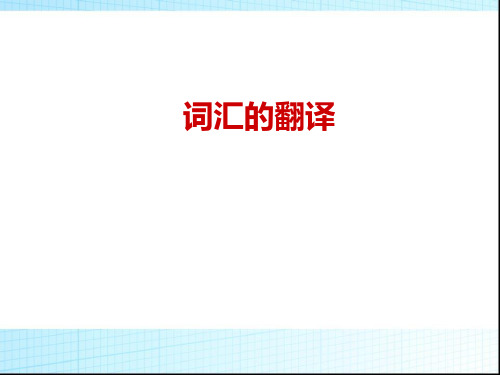
英汉词汇对比
词类系统
• 英汉语词类基本相似,都有名词、动词、形容词、 代词、副词、介词、连词、感叹词。 • 汉语量词发达,英语没有量词。 • 汉语有语气助词,英语没有。 • 英语有冠词,汉语没有。 • 英语中的关系代词、关系副词在汉语中够也没有 对应的词类。
用词倾向
• 1. 英语中名词、介词和形容词用得多。 • 2. 汉语中动词和量词用得多。 • 3. 碰到词语重复,英美人一般倾向于用替代形式 或者在不影响达意的前提下采用省略法。汉语则 不怕重复。 • 英语重形合,所以连词、介词之类的虚词和代词 用的多;汉语重意合,虚词用得少。
考察
• 中国明朝的著名旅行家徐霞客一生周游考察了16 个省,足迹几乎遍布全国。 • In his lifetime, Xu Xiake, a great traveler in China’s Ming Dynasty, toured 16 provinces, leaving his footmarks in nearly 察的过程中,从不盲目迷信书 上的结论。 • In the course of his exploration, he never took what have been recorded for granted.
• 裸官 • An official alone at home with his or her family members emigrated abroad • 月光族 • Referring to a group of young people who make both ends meet each month • 啃老族 • Who live off their parents • 耄耋之年 • Referring to the age from eighty to ninety
汉译英第一讲(词的翻译技巧)

课后练习
9 那个人就是他的哥哥。 10 我就不信我学不会。 11 你就是送给我,我也不要。 12 就我所知,他英语很好。 13 两国代表团就共同关心问题进行了会谈。 轻重: 1 这两口箱子轻重不一样。 2 工作应该分轻重缓急,不要眉毛胡子一把抓。 3 你别见怪,他说话就是不知道轻重。
词语搭配
heavy weather 阴沉的天气 heavy casualties 重大伤亡 heavy smoker 烟瘾很大的人 heavy vote 大量的得票 heavy schedule 紧凑的日程 heavy foliage 浓密的叶子 heavy sea 波涛汹涌的大海 heavy investor 巨额投资者 heavy rain 大雨 heavy thinker 思想深沉的人
英语中的惯用法
汉语可以说“吃饭”,也可以说“吃药”,但在英语 里可以说eat a meal,却不可以说eat medicine,而 应该说take medicine。 同样,英语可以说male doctor,也可以说male dog, 但译成汉语只能说“男医生”和“公狗”,不能说 “公医生”、“男狗”。 在英语中,人们说: 违规break rules 发表演说deliver a speech/make a speech
词语搭配
(5)我们可能去那儿,那得看情况而定。 We may go there, but that depends. (6)如何办理,到时候看情况再说。 As to how to deal with it, we shall have to wait and see. (7)她询问了他的健康情况。 She inquired about his health condition. (8)那个地方的情况很混乱。 That place is in a state of confusion.
(完整版)英汉翻译教程

英汉翻译教程张培基第一讲翻译原则简介一、教学目的:了解基本的翻译原则和翻译研究的问题二、教学过程:1.翻译的定义和内涵:(Definition and Connotation)Translation is an art/ science/craf2.中国几位翻译家的理论(influential translation principles)严复:信达雅-—- faithfulness/expressiveness/elegance。
The “three character guide" is regarded as a plumb—line of long standing to measure the professional level of translating.傅雷:神似--—spiritual conformity。
Emphasizing the reproduction of the spirit of the flavor of the original。
强调原作神韵再现。
钱钟书:化境--—sublimed adaptation. Focus on the translator’s smooth and idiomatic Chinese version for the sake of the Chinese reader.刘重德:信、达、切-——faithfulness/expressiveness/closeness.3.中国翻译史上的论争:鲁迅:宁信而不顺-—-rather to be faithful than smooth。
目的:引入英文句式的表达法梁实秋、赵景深:宁顺而不信--—rather to be smooth than faithful 目的:可读性强,便于交流.4.直译与意译:直译—--literal translation意译:free translation直译的例子:crocodile tears鳄鱼的眼泪; armed to the teeth武装到牙齿; chain reaction连锁反应;gentlemen's agreement君子协定; one country, two systems 一国两制;The three religions and the nine schools of thought 三教九流;paper tiger 纸老虎; Breath one’s last——-断气; go to one’s external rest——-安息; the long sleep——-长眠;see Marx 见马克思; Go west 上西天; go to heaven 上天堂; blow out the candles 吹灯拔蜡kick the bucket 蹬腿:直译不等于死译(dead translation):街道妇女应动员起来打扫卫生:Women in the street should be called on to do some cleaning.“In the street" should be replaced by “in the community”.她一大早起床,进城,见到了她的公爹:She got up early, went to the town and saw her public father。
中级口译翻译篇第一讲

• The United States has long been known as a “melting pot”. • 历来,长期以来
99.9真题
• Her main message was and is, “We’re like everybody else.” • 她(传递)的信息过去是、今天依然是: 我们和别人一样。
Develop
• • • • • • • • • • Develop a new drug 研制 Develop new products 开发 Develop muscles 锻炼 Develop the film 冲印 Develop a habit 养成
打
• • • • • • 打牌 打雷 打交道 打架 打猎 打瞌睡 • • • • • • Play cards Thunder Make contact with Fight Go hunting Doze off
缘
• 我在班里有人缘。 • I am popular with my classmates. • 聊得投缘 • talk congenially
缘
• • • • 无缘无故地 for no reason at all 不识庐山真面目,只缘身在此山中。 I can’t tell the true shape of Lu Shan because I myself am on the mountain. • 化缘 • beg for alms
• The loss of his family reduced him into despair. • 失去家人使他陷入绝望的境地。 • Many changes have taken place during the transformation. • 转化过程中发生了许多变化。
汉译英翻译常用技巧(一)ppt课件

4. 交出翻译之前, 必须读几遍, 看看有没有要修改的地 方. 这样你才能把工作做好。 Before handing in your translation, you have to read it over and over again and see if there is anything in it to be corrected or improved. Only thus can you do your work well.
汉英翻译的几种常用技巧 (一)
常用的翻译技巧
1. 增译 2. 减译(省译) 3. 重复 4. 转译
5. 语序(词序/句序)调整(倒置) 6. 拆句与合并 7. 正说反译, 反说正译 8. 语态变换
1. 增译法
增译法:指根据英汉两种语言不同的思维方式、语言习 惯和表达方式,在翻译时增添一些词、短句或句子,以 便更准确地表达出原文所包含的意义。
这种方式多半用在汉译英里。汉语无主句较多,而英语 句子一般都要有主语,所以在翻译汉语无主句的时候, 除了少数可用英语无主句、被动语态或“There be…” 结构来翻译以外,一般都要根据语境补出主语,使句子 完整。
英语中代词使用频率较高,凡说到人的器官和归某人所有的 或与某人有关的事物时,必须在前面加上物主代词。因此, 在汉译英时需要增补物主代词,而在英译汉时又需要根据情 况适当地删减。
减译法是删去一些可有可无的, 或者有了反而 累赘或违背译文习惯表达法的词, 并不是把原 文的某些思想内容删去。
The earth goes around the sun. 地球绕太阳转。
On Sundays we have no school. 礼拜天我们不上学。
If you write him, the response would be absolute silence and void.
大学英语四六级汉译英翻译技巧(1)

2.2.1 动词→名词 练习: (注意黑体部分的静态表达)
1.汉语的特点之一是动词占优势。
2. 学习外语非下苦功不可。 3. 他通晓多种不常使用的外国语,这使我 们大家感到惊讶。 4. 中国成功地爆炸了第一颗原子弹,在全世 界引起了巨大的反响。
2.2.1 动词→名词 练习答案
1.汉语的特点之一是动词占优势。 One of the characteristics of the Chinese language is the predominance of the verb. 2. 学习外语非下苦功不可。 The mastery of a foreign language demands pains-taking effort. 3. 他通晓多种不常使用的外国语,这使我们大家感到 惊讶。 His familiarity with many rarely used language surprised us all.
2.3.2 意思表达需要
Eg: 【原文】这是黄河滩上的一幕。 【译文】This is a scene taking place on the shore of the Yellow River. 【分析】在翻译“这是黄河滩上的一幕”时 ,增译taking place短语,使译文表达更为 生动贴切。
(介词与名词密切相关,英语名词的广泛使用使得 介词也得以频繁出现。而且英语中有些介词本身是 由动词演变而来的,具有动词的特征。因此,汉译 英时,有些动词可以用介词来表达。 Eg: 【原文】但通常每个家庭都会在除夕夜团聚, 一起吃年夜饭。 【译文】However, New Year’s Eve is usually an occasion for Chinese families to gather for the annual reunion dinner.
汉英翻技巧译第一讲词类转译法

we are against it, second, we are not afraid of it.
我们全体赞成他的建议。 We were all in favor of his suggestion. 我们不顾一切困难,挫折,坚持战斗。 They kept on fighting in spite of all
三.汉语动词转换成英语的介词或介词词组
与汉语相比,英语用介词较多,而且有一些英语 介词本是由动词演变而来的,具有动词的特征。 因此在汉译英时,汉语的一些动词常常可用英语 的介词或介词词组来翻译。如:
孩子们都上一个学堂。 The children are in the same school. 我们对待世界大战这个问题的态度是,第一,反
记住我永远支持你。 Remember that I am always with you. 那个家伙老是滔滔不绝讲个不停。 That fellow is very talkative. 他读书时不加选择。 He is indiscriminate in reading. 他们迫切地想弄到消息。 They were news-hungry. 你们现在得走了。 You must be off now.
演出已经开始了。 The Performance is on. 她非常漂亮。 She is a real beauty. 那个家伙笨得出奇。 That fellow is a typical fool.
在翻译实践中,要做到既忠实于原文又符 合译文语言规范,有时就需要适当改变一 些词类,即把原文中属于某种词类的词在 译文中转换成另一种词类。这就是翻译上 通常所说的“词类转换”。
英汉互译技巧
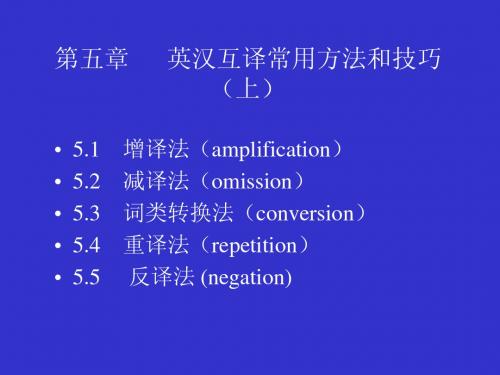
5.1.1 英译汉中的增词法
7. 概括性增词
e.g. • the United States, Russian, England and France 美俄英法四国 • militarily, politically and economically 军事、政治、经济等各方面 • The Americans and the Japanese conducted a completely secret exchange of messages. 美日双方在完全保密的情况下互换了信件。 • The thesis summed up the new achievements made in electronic computers, artificial satellites and rockets. 论文总结了电子计算机、人造卫星和火箭三方面的新 成就。
5.1.1 英译汉中的增词法
bandits / animals 匪邦(加“类、种、界”等) directions / the Americas 南北美洲(具体到子项) hills / rivers 一座座山(量词重叠)
• The lion is the king of animals. • The mountains began to throw their long blue shadows over the valley. • The nations of America are equally sovereign and independent with those of Europe.
第五章
英汉互译常用方法和技巧 (上)
• • • • •
5.1 5.2 5.3 5.4 5.5
增译法(amplification) 减译法(omission) 词类转换法(conversion) 重译法(repetition) 反译法 (negation)
汉英翻技巧译第一讲词类转译法

三.汉语动词转换成英语的介词或介词词组
与汉语相比,英语用介词较多,而且有一些英语 介词本是由动词演变而来的,具有动词的特征。 因此在汉译英时,汉语的一些动词常常可用英语 的介词或介词词组来翻译。如: 孩子们都上一个学堂。 The children are in the same school. 我们对待世界大战这个问题的态度是,第一,反 对;第二,不怕。 Our attitude on the question of world war is , first, we are against it, second, we are not afraid of it.
在翻译实践中要做到既忠实于原文又符在翻译实践中要做到既忠实于原文又符合译文语言规范有时就需要适当改变一合译文语言规范有时就需要适当改变一些词类即把原文中属于某种词类的词在些词类即把原文中属于某种词类的词在译文中转换成另一种词类
汉英翻译技巧
第一章 词类转换法
第一章 词类转译法
一、汉语的动词转换成英语的名词 二、汉语的动词转换成英语的形容词 三、汉语的动词转换成英语的介词或介词 词组 四、汉语的形容词或副词转换成英语的名 词 五、汉语的名词转换成英语的动词
一.汉语的动词转换成英语的名词
汉语中动词用得较多,除大量的动宾结构 外,还有连动式、兼语式等两个以上动词 连用的现象。而英语则不然,一句话往往 只用一个谓语动词,而且英语的名词也比 汉语的名词用得多。由于两种语言各自所 具有的这种特点,汉译英时常常需要把汉 语动词转换成英语名词。有时,随着汉语 动词的这种转换,修饰该动词的副词也自 然需要转换。请看下列例句:
他们教导我们要珍惜每一个机会。 They taught us the value of an opportunity. 他长期以来习惯于在最后一分钟作出决定。 He has long been used to last-minute decisions. 她对他们越来越憎恨。 Her hatred for them grew more. 他酷爱古典音乐。 He is an ardent lover of classical music. 他指挥着一个团。 He is a commander of a regiment.
汉译英——精选推荐
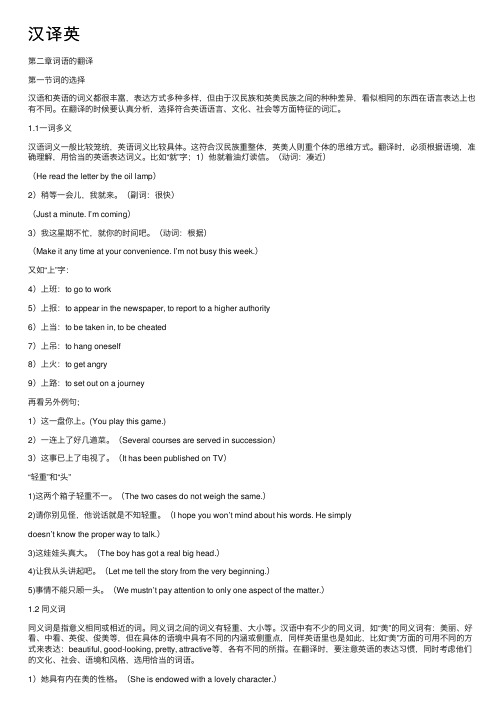
汉译英第⼆章词语的翻译第⼀节词的选择汉语和英语的词义都很丰富,表达⽅式多种多样,但由于汉民族和英美民族之间的种种差异,看似相同的东西在语⾔表达上也有不同。
在翻译的时候要认真分析,选择符合英语语⾔、⽂化、社会等⽅⾯特征的词汇。
1.1⼀词多义汉语词义⼀般⽐较笼统,英语词义⽐较具体。
这符合汉民族重整体,英美⼈则重个体的思维⽅式。
翻译时,必须根据语境,准确理解,⽤恰当的英语表达词义。
⽐如“就”字;1)他就着油灯读信。
(动词:凑近)(He read the letter by the oil lamp)2)稍等⼀会⼉,我就来。
(副词:很快)(Just a minute. I’m coming)3)我这星期不忙,就你的时间吧。
(动词:根据)(Make it any time at your convenience. I’m not busy this week.)⼜如“上”字:4)上班:to go to work5)上报:to appear in the newspaper, to report to a higher authority6)上当:to be taken in, to be cheated7)上吊:to hang oneself8)上⽕:to get angry9)上路:to set out on a journey再看另外例句;1)这⼀盘你上。
(You play this game.)2)⼀连上了好⼏道菜。
(Several courses are served in succession)3)这事已上了电视了。
(It has been published on TV)“轻重”和“头”1)这两个箱⼦轻重不⼀。
(The two cases do not weigh the same.)2)请你别见怪,他说话就是不知轻重。
(I hope you won’t mind about his words. He simplydoesn’t know the proper way to talk.)3)这娃娃头真⼤。
汉译英翻译技巧
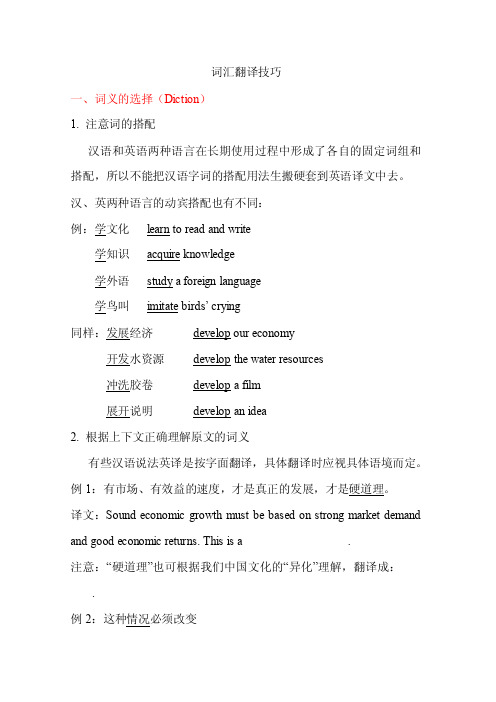
词汇翻译技巧一、词义的选择(Diction)1. 注意词的搭配汉语和英语两种语言在长期使用过程中形成了各自的固定词组和搭配,所以不能把汉语字词的搭配用法生搬硬套到英语译文中去。
汉、英两种语言的动宾搭配也有不同:例:学文化learn to read and write学知识acquire knowledge学外语study a foreign language学鸟叫imitate birds’ crying同样:发展经济develop our economy开发水资源develop the water resources冲洗胶卷develop a film展开说明develop an idea2. 根据上下文正确理解原文的词义有些汉语说法英译是按字面翻译,具体翻译时应视具体语境而定。
例1:有市场、有效益的速度,才是真正的发展,才是硬道理。
译文:Sound economic growth must be based on strong market demand and good economic returns. This is a .注意:“硬道理”也可根据我们中国文化的“异化”理解,翻译成:.例2:这种情况必须改变译文:This must change.分析:此处要正确理解原文的词义。
汉语措辞中的“情况”一词的基本意义与英语中的circumstance, situation, condition等词相近,但是究竟怎样翻译,还需要根据上下文来决定。
二、词的增补(Amplification)词的增补又常叫增译/增词法,是为使译文准确、通顺、达意。
增译有语义性增译修辞性增译,还有注释性增译(文内阐释或文中夹注)1.增补主语汉语中无主语的句子很多,汉译英时要根据上下文的意思选择适当的代词或名词补做主语。
增加什么主语取决于上下文。
例1:知己知彼,百战不殆译:2. 增补非人称的或强调句中的itit可以指天气、时间,还常用来表示强调、代替不定式等。
01汉译英第一讲

Multi-point Perspective
。
汉英思维方式与语言差异(thinking patterns and language differences)
1.整体与个体(macrocosm vs. individuality) 2.悟性与理性(comprehension vs. rationality :汉语的模糊性(词性模糊、 语义模糊、语言单位模糊) 3.具象与抽象(concreteness vs. abstractness) 4.直觉与逻辑(intuition vs. logic)
(1)忠实:“忠实”指译文要忠实原文,准确表达其 思想,意义和文体风格。 例1:我的成功一半要归功于他。 译文1:Half of my success belonged to him. 译文2:I owed half of my success to him. 例2: 这台发动机出了毛病。 译文1:The generator has got some problems. 译文2:There is something wrong with the generator. 例3:啊!我不是诗人,我永远道不出我的爱,一种像 由音乐与图画所引起的爱。 译文1: Alas, I am not a poet! I shall never express my love, a love which is caused by music and painting. 译文2:Alas, I am not a poet! I shall never be able to express my love--- the kind of love as inspired by music and painting.
汉译英翻译技巧讲解一(词的翻译)
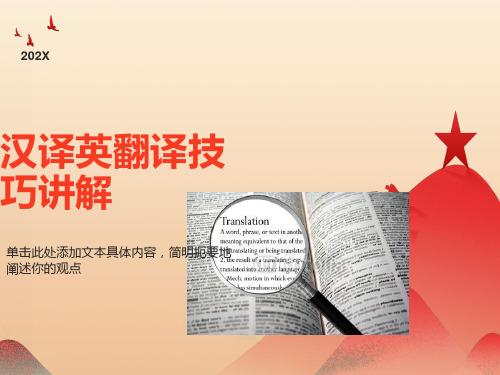
再确定修饰成分如定语、状语、补语等。
03
1.理清句子主干
二、句子的翻译 (1)
一、词的翻译
词义选择 增词 减词 词性转换
词义选择 汉英两种语言在具体运用中,词义往往随着语言情境而变,同样一个汉语词,翻译成英文时不是一成不变的,选用什么词得根据不用的语境而变。
例如: 汉语中的“大”在英语中根据不同语境翻译也不同,“大城市”译为 a big city,但是“大雨”就译成heavy rain,再来看看下面几个词怎么翻译:
It’s becoming fashionable again to have
popular traditional folk arts. 注解:“流行”在第一句中是指时尚、时髦,因此译为fashionable比译成常用的popular要更加合适;而在第二句 中“流行”指普遍的、受欢迎的,即可
03
答案:
Thank you!
It was widespread/popular particularly during the Ming and Qing dynasties.(动转形容词)
在明朝和清朝时期特别流行。
练习:
农业发展在养活中国庞大人口方面起着很重要的作用。
中国剪纸有一千五百多年的历史。
从20世纪50年代开始,政府鼓励居民植树造林、退耕还林。
We must cultivate the ability to analyze and solve problems. 我们必须培养分析问题、解决问题的能力。
词性转换 汉译英时,为了让译文更加通顺,有时要适当改变词性进行翻译。汉语中动词用的多,因此,汉译英时常见的是将汉语的动词转换为英语的名词、形容词、介词短语等,使译文更符合英语的表达习惯。
- 1、下载文档前请自行甄别文档内容的完整性,平台不提供额外的编辑、内容补充、找答案等附加服务。
- 2、"仅部分预览"的文档,不可在线预览部分如存在完整性等问题,可反馈申请退款(可完整预览的文档不适用该条件!)。
- 3、如文档侵犯您的权益,请联系客服反馈,我们会尽快为您处理(人工客服工作时间:9:00-18:30)。
词语搭配
例2:(1)他有钥匙,但是没有锁。 He has the key, but not the lock. (2)离开屋子时,请把门锁上。 Please lock the door when you leave the room. 例3:(1) 山坡上种了许多树。 There are many trees planted on the hill slope. (2) 十年树木,百年树人。 It takes ten years to grow trees, but one hundred
civilization. 例7:环境卫生 /个人卫生/ 公共卫生 environmental sanitation/personal hygiene/public health
词语搭配
课堂练习:仔细思考下下面的搭配如何处理: 发扬主人翁精神/发扬优良传统/发扬民主/发扬光大 打毛衣/打酒/ 打杂儿 /打官腔 /打水 /打针 /打铁/打人/ 打井/打电话 发展同各国人民的友谊/发展新党员 /发展新会员/发展
词语搭配
他主抓工业。 抓:负责,掌管 He is in charge of industry. 抓养猪 抓:重视 attach importance to pig-breeding “两手抓,两手都要硬。” (重视) We should lay equal emphasis on material and spiritual
lodge a protest /pose a cfute/counter-revolution/inverse function one’s line (occupation)/original idea/to be honest/put the car before the horse symptom of a trend/benefit/enemy seaman/technician/research fellow/typist/official
汉译英(二)
词的翻译技巧
词语搭配
例1:汉语中的“假”在不同的搭配中意义不同。 假话、假画、假花、假钞、假酒、假唱 分别表示: 不诚实的、伪造的、人造的、仿造的、掺杂劣质物的、
跟着磁带不出声的。 因此宜分别译为: lie, fake picture, artificial flower,
counterfeit money, adulterated wine, lip-sync
从以上练习可以看出,汉译英时,必须根据不同的汉语 词语搭配和含义,选择不同的对应的英语词汇;当然 有时候,同一个英语单词,也对应不同的汉语词汇。
and see. (7)她询问了他的健康情况。 She inquired about his health condition. (8)那个地方的情况很混乱。 That place is in a state of confusion.
词语搭配
例5:拉门 pull the door 拉断 pull apart 拉开抽屉 pull open the drawer 他拉了拉我的袖子。 He pulled my sleeve. 拉拉手 shake hands 拉拉队 cheering squad 拉肚子 diarrhea 拉倒 forget about it
词语搭配
Pull a tooth 拔牙 Pull in (车)进站 Pull together 齐心协力 Pull round 恢复健康 例6:狗正在抓门。 The dog is scratching at the door.
他假装搔耳朵。 He pretended to scratch his ear. 狗把她的手抓了。 The dog scratched her hand.
经济,保障供给/用发展的眼光看待问题 提出抗议/提出挑战 反话/反驳/反革命/反函数 本行/本意/本来话/本末倒置 苗头/甜头/对头 海员/技术员/研究员/打字员/官员
词语搭配
in “master” spirit/carry forward fine traditions/do sth. democratically/carry forward
control. (4)前面有情况,做好战斗准备。 There’s enemy activity ahead. Prepare for
combat.
词语搭配
(5)我们可能去那儿,那得看情况而定。 We may go there, but that depends. (6)如何办理,到时候看情况再说。 As to how to deal with it, we shall have to wait
years to rear people.
词语搭配
例4 (1)现在情况不同了。 Now things are different. (2)前线有什么情况? How is the situation at the front? (3)总统称局面已经得到了控制。 The president said the situation was under
knit a sweater/buy alcohol / do odds and ends/talk like a bureaucrat/draw water/get an injection/forge iron/hit sb./drill a well/make a phone call
develop friendship with peoples from other countries/ accept Party members / draft new members/develop the economy and ensure supplies / take the view angle of development to treat issues
